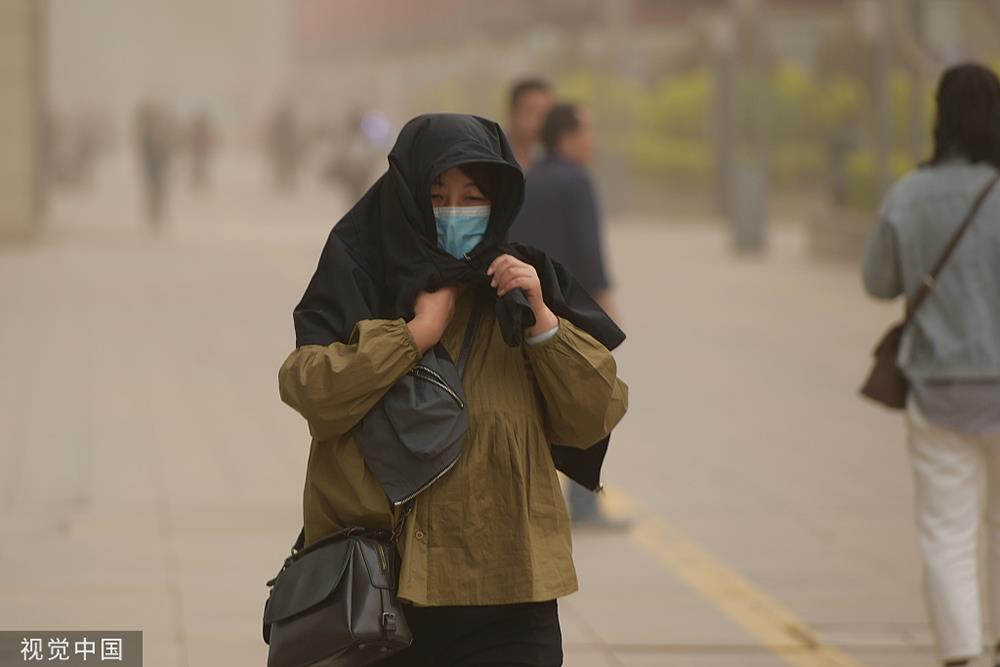In April, more than 7.94 million people were affected by natural disasters in China, and the sandstorm weather was more than normal.

On April 19, 2023, Yinchuan City was shrouded in dust. People’s visual data map
Recently, the Emergency Management Department, together with relevant departments and units, conducted a consultation and analysis on the national natural disasters in April 2023.
The Paper learned that in April, natural disasters in China were mainly wind and hail, drought and low temperature freezing, and floods, geological disasters, sandstorms, earthquakes, snowstorms and forest and grassland fires also occurred to varying degrees. A total of 7.942 million people were affected by various natural disasters, 7 people died and 10,000 people were resettled. More than 500 houses collapsed, with more than 2,600 seriously damaged and 68,000 generally damaged; The affected area of crops is 731.2 thousand hectares; The direct economic loss was 5.44 billion yuan.
The main features of natural disasters in April are:
1. The wind and hail disasters affect Hunan, Guizhou and other places, and the dust weather process is more than normal. In April, there were six severe convective weather processes in China, and 332 counties in 23 provinces (autonomous regions and municipalities) suffered from severe convective weather such as hail, strong wind and short-term heavy rainfall, which caused some houses and facilities agriculture to be affected, among which disasters in Hunan, Guizhou and Jiangxi had a greater impact. The wind and hail disaster caused 1.069 million people in the country to be affected. Five people died, 63,000 houses were damaged and the direct economic loss was 1.6 billion yuan. In addition, in April, there were six dust storms affecting China, more than the same period of normal years. Among them, the process on April 9-13 and 27-29 was sandstorm level, and it reached strong sandstorm level on April 18-21, causing local crops in North China and Northwest China to suffer.
Two, northwest, north China and other places suffered from low temperature freezing and snow disaster. In April, there were five cold air processes affecting China, more than normal. Among them, April 21-24 is a national cold wave process, which has a large cooling range and a wide range of influence, causing freezing of local fruit trees and damage to protected agriculture in northwest and north China. In general, low-temperature freezing and snowstorm caused 1.327 million people to be affected in 11 provinces (regions) such as Shanxi, Gansu and Shaanxi, and the affected area of crops was 1.899 thousand hectares, resulting in a direct economic loss of 1.36 billion yuan.
Third, floods and geological disasters occurred in the southern part of the country, and the ice flood situation in the northeast was stable. In April, four heavy rains occurred in China, and 32 rivers were flooded beyond the police. The flood disaster caused 523,000 people to be affected in 15 provinces (autonomous regions and municipalities) such as Hunan, Hubei and Fujian, and damaged more than 7,800 houses, resulting in a direct economic loss of 620 million yuan. As of May 1st, Nenjiang River, Songhua River and Heilongjiang River have all opened their rivers. During the opening of the river, the ice situation was stable and there was no major danger or disaster. In addition, geological disasters such as collapse and landslide occurred in Guangxi and Guizhou.
4. The drought in Yunnan, Sichuan and other places continued to develop, and forest and grassland fires occurred frequently in some areas. In April, the moisture content in most parts of the country was generally suitable, and the soil in some parts of southwest China was moderately deficient. Since mid-April, there has been obvious precipitation in Chongqing, most of Guizhou, eastern Sichuan and other places, which has effectively improved soil moisture, replenished water storage in reservoirs and ponds, and alleviated the drought; Precipitation in most parts of Yunnan and southern Sichuan is still low, and the temperature is high in the same period. The drought in the two places continues to develop. Due to the drought, 870,000 people need life assistance, and the affected area of crops is 295.5 thousand hectares. In April, there were 56 forest fires in China, mainly in Yunnan, Guangxi, Shandong and Sichuan. There were 8 grassland fires, all of which occurred in Inner Mongolia.
In addition, in April, there were three earthquakes of magnitude above 4 in mainland China, with the largest magnitude of 4.6 in Baicheng, Xinjiang on April 7, which did not cause disaster losses; A small number of houses were slightly damaged by the 4.0 earthquake in Huidong, Sichuan on April 2.